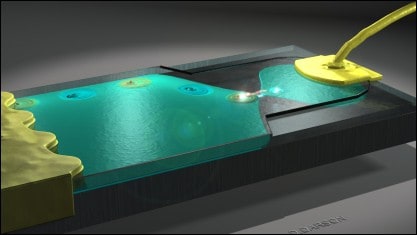Physicists in France have taken an important step forward in building a quantum computer from entangled electrons. They have shown that tiny regions of semiconductor known as quantum dots can be made to emit single electrons on the nanosecond timescales over which current electronic devices operate (Science 316 1172).

Classical computers process information by performing operations on successive “bits”, which can be either 0 or 1. Quantum computers, on the other hand, use the phenomenon of entanglement to operate on quantum bits, or “qubits”, which can be both 0 and 1 at the same time. The ability to process many values simultaneously should in principle mean that quantum computers can vastly outperform their classical counterparts when performing certain tasks.
New research by Christian Glattli and colleagues at the Ecole Normale Supérieure and other French institutions provides a step forward for one of the most promising ways of building a qubit – confining electrons to two dimensions in a semiconductor (a system known as a 2D electron-gas (2DEG)). Glattli and coworkers took a slab of the semiconductor gallium arsenide and doped it so as to make a quantum dot at one end of the slab and a large 2DEG at the other, with a tunnel barrier in between. By applying a rapidly alternating voltage across the quantum dot and then a static voltage across the tunnel barrier they were able to shift the energy levels of the electrons in the quantum dot such that the electrons could enter or exit the 2DEG.
Quantum dots have been used as single-electron sources before, but the device made by the French group is the first to be able to emit and absorb electrons over intervals of just a few nanoseconds, which makes the device’s speed comparable with present-day electronics. They did this by assuming that the quantum-dot and gate components are analogous to a resistor and capacitor in series, then used RC circuit principles to calculate the combined impedance of the quantum dot and gate, and therefore how frequently electrons would be emitted from the quantum dot given the voltage across the system.
To actually make qubits, Glattli’s team will need to demonstrate that two single-electron emitters can generate electrons coherently, and that the resulting entangled state can be maintained for longer than about a microsecond, according to solid-state physicist Stephen Giblin.



